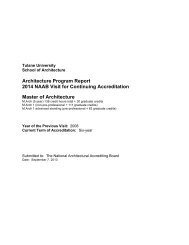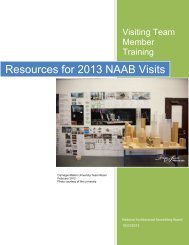Architecture Program Report Tulane University New Orleans ...
Architecture Program Report Tulane University New Orleans ...
Architecture Program Report Tulane University New Orleans ...
Create successful ePaper yourself
Turn your PDF publications into a flip-book with our unique Google optimized e-Paper software.
of the curriculum (the “microscale” being taught by Professor Byron<br />
Mouton) (DSGN 410, 420).<br />
Accessibility is introduced as a necessary component in site planning and<br />
building design in the First-year Introduction to <strong>Architecture</strong> course and in<br />
the Core Design Studios. The first, second and fourth courses in the<br />
required Technology sequence (ATCS 110, ATCS 310, ATCS 420) focuses<br />
and elaborates on issues of accessibility, and the focus and application of<br />
accessibility requirements is further reinforced in the Third-year<br />
Comprehensive Design Studio (the third semester of design for the<br />
Masters of <strong>Architecture</strong> students) as a significant element of consideration.<br />
At the end of this studio, the student’s design work must demonstrate the<br />
incorporation of accessibility requirements for individuals with varying<br />
physical abilities.<br />
As might be expected, the Master in Preservation Studies <strong>Program</strong> focuses<br />
on this issue during the course of the degree (and certificate) program.<br />
The incorporation of accessibility requirements is a significant issue in the<br />
preservation and use of existing historical structures. Sensitive<br />
accommodation of these requirements is a fundamental component of a<br />
design preservationist’s ability.<br />
At present, the Thesis Studio (DSGN 510, DSGN 520) also demands the<br />
accommodation of accessibility requirements in the student’s projects of<br />
they are designing a building for public use. With the introduction of a<br />
Comprehensive Studio in the spring semester of the Third-year (DSGN<br />
320), students will no longer have to demonstrate accessibility in thesis if it<br />
is accessory to the thesis research and development.<br />
In addition, the Concerns of the Profession course (APFC 410) focuses on<br />
the issue of accessibility in several of its lectures, with specific attention<br />
given to the ADA, Building Codes, and the ethical responsibility of the<br />
architect in this regard.<br />
Other opportunities in which students are asked to consider Accessibility<br />
issues are in the Preservation Studies courses (PRST series), in particular<br />
those buildings that are restored and reprogrammed for the public. In this<br />
sense, accessibility becomes a particularly critical issue, as it applies to the<br />
accommodation of public function(s).<br />
15. Sustainable Design<br />
Understanding of the principles of sustainability in making architecture and<br />
urban design decisions that conserve natural and built resources, including<br />
culturally important buildings and sites, and in the creation of healthful<br />
buildings and communities.<br />
The topic of sustainable design is dealt with in several places in the<br />
curriculum, some required and some ‘required electives.’ All students<br />
become familiar with sustainable design throughout the course of their<br />
education.<br />
Technological Systems I (ATCS 110) (Professor B. Mouton) and














